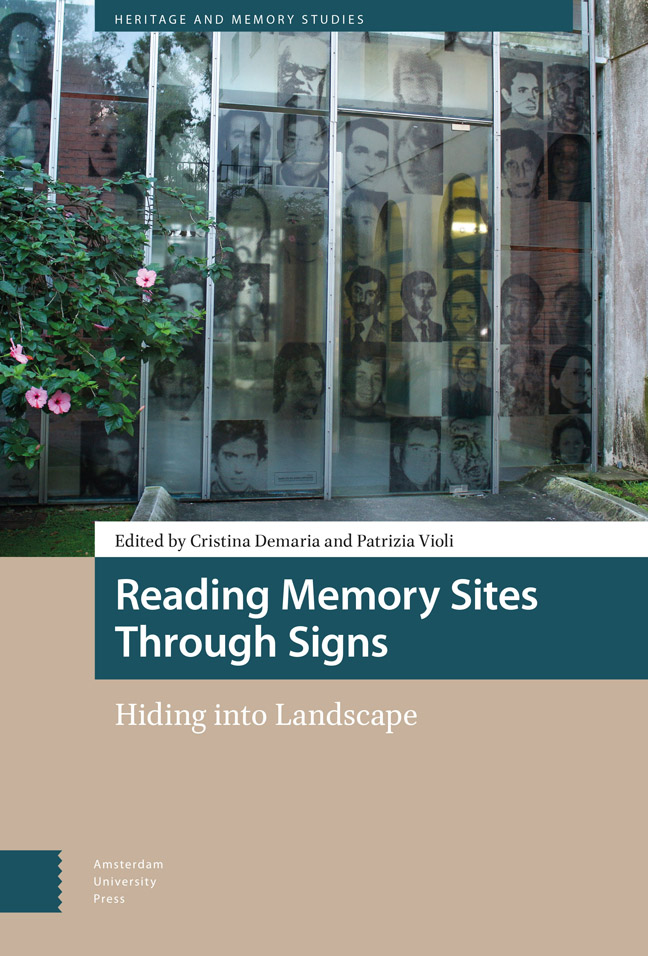Book contents
- Frontmatter
- Contents
- List of Illustrations
- For a Semiotics of Spaces of Memories: Practices of Enunciation and Narratives from Monuments to Global Landscapes of Inheritance
- 1 Stories that Shape Spatialities: Lieu and Milieu de Mémoire through the Lens of Narrativity
- 2 Interpretation and Use of Memory: How Practices Can Change the Meanings of Monuments
- 3 Uncomfortable Memories of Fascist Italy: The Case of Bigio of Brescia
- 4 What Does Fascist Architecture Still Have to Tell Us?: Preservation of Contested Heritage as a Strategy of Re-Enunciation and ‘Voice Remodulation’
- 5 Berlin, the Jewish Museum and the Holocaust Memorial
- 6 Making Space for Memory: Collective Enunciation in the Provincial Memory Archive of Córdoba, Argentina
- 7 Ruins of War: The Green Sea and the Mysterious Island
- 8 Turning Spaces of Memory into Memoryscapes: Cinema as Counter-Monument in Jonathan Perel's El Predio and Tabula Rasa
- 9 Voices from the Past: Memories in a Digital Space: The Case of AppRecuerdos in Santiago, Chile
- 10 500,000 Dirhams in Scandinavia, from Mobile Silver to Land Rent: A Semiotic Analysis
- Index
- Index of Names
7 - Ruins of War: The Green Sea and the Mysterious Island
Published online by Cambridge University Press: 17 February 2024
- Frontmatter
- Contents
- List of Illustrations
- For a Semiotics of Spaces of Memories: Practices of Enunciation and Narratives from Monuments to Global Landscapes of Inheritance
- 1 Stories that Shape Spatialities: Lieu and Milieu de Mémoire through the Lens of Narrativity
- 2 Interpretation and Use of Memory: How Practices Can Change the Meanings of Monuments
- 3 Uncomfortable Memories of Fascist Italy: The Case of Bigio of Brescia
- 4 What Does Fascist Architecture Still Have to Tell Us?: Preservation of Contested Heritage as a Strategy of Re-Enunciation and ‘Voice Remodulation’
- 5 Berlin, the Jewish Museum and the Holocaust Memorial
- 6 Making Space for Memory: Collective Enunciation in the Provincial Memory Archive of Córdoba, Argentina
- 7 Ruins of War: The Green Sea and the Mysterious Island
- 8 Turning Spaces of Memory into Memoryscapes: Cinema as Counter-Monument in Jonathan Perel's El Predio and Tabula Rasa
- 9 Voices from the Past: Memories in a Digital Space: The Case of AppRecuerdos in Santiago, Chile
- 10 500,000 Dirhams in Scandinavia, from Mobile Silver to Land Rent: A Semiotic Analysis
- Index
- Index of Names
Summary
Abstract
This chapter provides a semiotic investigation of an emblematic space in Palermo, the Foro Italico. After the Second World War, this space was occupied for many years by the ruins left when the city was bombed. Analysing the diachronic evolution of the Foro Italico, the author examines the semantic categories that have defined the space, exploring how the memory of the war has been concealed and inscribed in the post-war rewritings of the place. The chapter reads this space as ‘a mysterious island’, caught between nature and culture. Referring to different kinds of texts, Marrone illustrates how the practices of various local and migrant communities contribute not only to the resemantisation of space but also to the production of new memories.
Keywords: Semiotics; Ruins; Terrain Vague; Semiotic Square; Foro Italico
Introduction: a Bombing
In the spring of 1943, in the middle of the Second World War, the city of Palermo was subjected to a merciless aerial bombing campaign. The Allies had arrived in Africa at the end of 1942 and Palermo, whose port was of particular importance to the Axis powers, had become a crucial point in the anti-aircraft surveillance network organised in the Mediterranean by the Germans. By February 1943, the Allies, having established bases in Morocco and Algeria, were making their presence felt, and in April the destruction of the city began. Over the course of that month, ‘flying fortresses’ struck Palermo four times, using phosphorus and incendiary bombs. On 18 April, a bomb hit an air raid shelter, indiscriminately massacring unknown numbers of people, women and children in particular. But it was on 9 May that the Allies unleashed hell on the city. It was a dark, tragic and unforgettable day for those who experienced the event first hand. Three air raids were carried out. During the first, at noon, 23 Vickers Wellington planes dropped 76 explosive devices, including two 4,000-pound high-capacity bombs that did not penetrate the earth but proved lethally efficient at destroying built-up areas. The incursion by another 90 attack bombers, escorted by 60 twin-engine fighters, came a few hours later. Another 100 Flying Fortresses with their fighter escorts came that same evening.
Palermo was the test site for the first carpet-bombing in Italy. The city and all its military targets were hit by circa 1,110 227-kg bombs and another 460 136-kg bombs.
- Type
- Chapter
- Information
- Reading Memory Sites through SignsHiding into Landscape, pp. 183 - 206Publisher: Amsterdam University PressPrint publication year: 2023



